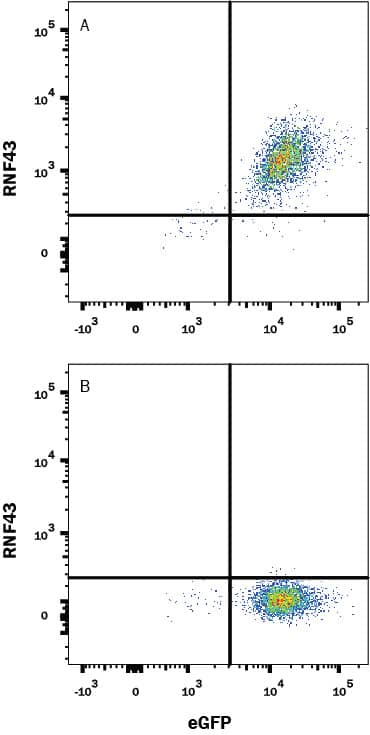Human RNF43 Antibody
R&D Systems, part of Bio-Techne | Catalog # MAB7964


Key Product Details
Species Reactivity
Applications
Label
Antibody Source
Product Specifications
Immunogen
Glu43-Val199
Accession # Q68DV7
Specificity
Clonality
Host
Isotype
Scientific Data Images for Human RNF43 Antibody
Detection of RNF43 in HEK293 Human Cell Line Transfected with Human RNF43 and eGFP by Flow Cytometry.
HEK293 human embryonic kidney cell line transfected with either (A) human RNF43 or (B) irrelevant transfectants and eGFP was stained with Mouse Anti-Human RNF43 Monoclonal Antibody (Catalog # MAB7964) followed by APC-conjugated Anti-Mouse IgG Secondary Antibody (Catalog # F0101B). Quadrant markers were set based on control antibody staining (Catalog # MAB002). View our protocol for Staining Membrane-associated Proteins.Applications for Human RNF43 Antibody
CyTOF-ready
Flow Cytometry
Sample: HEK293 Human Cell Line Transfected with Human RNF43 and eGFP
Formulation, Preparation, and Storage
Purification
Reconstitution
Formulation
Shipping
Stability & Storage
- 12 months from date of receipt, -20 to -70 °C as supplied.
- 1 month, 2 to 8 °C under sterile conditions after reconstitution.
- 6 months, -20 to -70 °C under sterile conditions after reconstitution.
Background: RNF43
RING finger protein 43 (RNF43) is a 90 kDa member of the ZNRF3 family of ubiquitin ligase proteins (1, 2). Human RNF43 is synthesized as a 783 amino acid (aa) protein that contains a putative 23 aa signal sequence, a 174 aa extracellular domain (ECD), a transmembrane domain, and a cytoplasmic domain with an atypical RING-type zinc finger (1). RNF43 is expressed in stem cells at the bottom of colon crypts, where it limits the ability of Wnts to induce proliferation (3). RNF43 and ZNRF3, another transmembrane E3 ubiquitin ligase, ubiquitinate and promote the turnover of Frizzled Wnt receptors to antagonize Wnt signaling (3, 4). RNF43 has been shown to suppress both canonical and non-canonical Wnt signaling pathways by distinct mechanisms (5). RNF43/ZNRF3-mediated turnover of Frizzled receptors is inhibited by R-Spondin (4). Dishevelled, a positive regulator of Wnt signaling, interacts with RNF43/ZNRF3 to mediate turnover of Frizzled receptors (6). RNF43 may promote cell survival by binding to NEDL1 and by suppressing the transcriptional activity of p53 (7, 8). RNF43 has been shown both to inhibit and promote cancer. Deletion of RNF43, as well as mutations found in colorectal and other cancers, allows hypersensitivity to Wnts and promotes adenoma formation (3, 9). Furthermore, RNF43 down-regulation in gliomas is associated with poor prognosis (10). However, RNF43 is frequently over-expressed in cancers, correlating with growth-promoting activity and colorectal and hepatocellular cancer pathogenesis (1, 7, 11).
References
- Yagyu, R. et al. (2004) Int. J. Oncol. 25:1343.
- de Lau, W. et al. (2014) Genes Dev. 28:305.
- Koo, B.K. et al. (2012) Nature 488:665.
- Hao, H.X. et al. (2012) Nature 485:195.
- Tsukiyama, T. et al. (2015) Mol. Cell. Biol. 35:2007.
- Jiang, X. et al. (2015) Mol. Cell 58:522.
- Xing, C. et al. (2013) Mol. Cancer Ther. 12:94.
- Shinada, K. et al. (2011) Biochem. Biophys. Res. Commun. 404:143.
- Giannakis, M. et al. (2014) Nat. Genet. 46:1264.
- Xi, S. et al. (2015) Int. J. Clin. Exp. Pathol. 8:490.
- Uchida, N. et al. (2004) Clin. Cancer Res. 10:8577.
Long Name
Alternate Names
Gene Symbol
UniProt
Additional RNF43 Products
Product Documents for Human RNF43 Antibody
Product Specific Notices for Human RNF43 Antibody
For research use only